Limiting reactant - Study guides, Class notes & Summaries
Looking for the best study guides, study notes and summaries about Limiting reactant? On this page you'll find 273 study documents about Limiting reactant.
Page 4 out of 273 results
Sort by
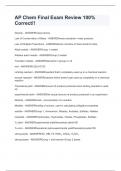
-
AP Chem Final Exam Review 100% Correct!!
- Exam (elaborations) • 8 pages • 2024
- Available in package deal
-
- CA$21.75
- + learn more
Density - ANSWERmass/volume Law of Conservation of Mass - ANSWERmass reactants= mass products Law of Multiple Proportions - ANSWERatoms combine in fixed whole # ratios Alkali metals - ANSWERGroup 1 metals Alkaline earth metals - ANSWERGroup 2 metals Transition metals - ANSWERelements in groups 3-12 mol - ANSWER6.022x10^23 Limiting reactant - ANSWERreactant that's completely used up in a chemical reaction excess reactant - ANSWERreactant which doesn't get used up complet...
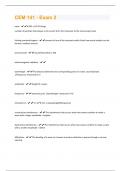
-
CEM 141 - Exam 2 Questions With 100% Correct Answers.
- Exam (elaborations) • 9 pages • 2023
- Available in package deal
-
- CA$11.59
- + learn more
mole - 6.022 x 10^23 things number of particles that allows us to convert from the molecular to the macroscopic level limiting reactant/reagent - amount of one of the reactants which limits how much product can be formed. smallest amount. percent yield - actual/theoretical x 100 electromagnetic radiation - wavelength - The distance between two corresponding parts of a wave. seconds/wave. 1/frequency. measured in m amplitude - Height of a wave frequency - waves/second. 1/wavelength. mea...
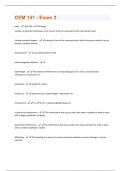
-
CEM 141 - Exam 2 Questions And Answers Rated A+ New Update Assured Satisfaction
- Exam (elaborations) • 8 pages • 2024
- Available in package deal
-
- CA$11.59
- + learn more
mole - 6.022 x 10^23 things number of particles that allows us to convert from the molecular to the macroscopic level limiting reactant/reagent - amount of one of the reactants which limits how much product can be formed. smallest amount. percent yield - actual/theoretical x 100 electromagnetic radiation - wavelength - The distance between two corresponding parts of a wave. seconds/wave. 1/frequency. measured in m amplitude - Height of a wave frequency - waves/second. 1/wavelength. meas...
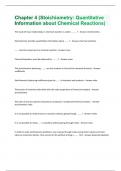
-
Chapter 4 (Stoichiometry: Quantitative Information about Chemical Reactions) Questions And Answers With Latest Updates
- Exam (elaborations) • 4 pages • 2024
- Available in package deal
-
- CA$11.59
- + learn more
The study of mass relationships in chemical reactions is called ₋₋₋₋₋₋₋ ? - Answer-stoichiometry Stoichiometry provides quantitative information about ₋₋₋₋₋ ? - Answer-chemical reactions ₋₋₋₋₋ must be conserved in a chemical reaction - Answer-mass Chemical Equations must be balanced for ₋₋₋₋₋₋ ? - Answer-mass The stoichiometric balancing ₋₋₋₋₋₋ are the numbers in front of the chemical formulas - Answercoefficients Stoichiometric bala...
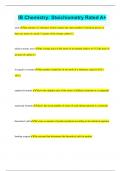
-
IB Chemistry: Stoichiometry Rated A+
- Exam (elaborations) • 2 pages • 2024
- Available in package deal
-
- CA$11.59
- + learn more
IB Chemistry: Stoichiometry Rated A+ mole the amount of a substance which contains the same number of chemical species as there are atoms in exactly 12 grams of the isotope carbon-12 relative atomic mass the average mass of the atoms of an element relative to 1/12 the mass of an atom of carbon-12 Avogadro's constant the number of particles in one mole of a substance; equal to 6.02 x 10^23 empirical formula shows the simplest ratio of the atoms of different elements in a compound ...
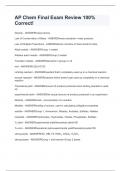
-
AP Chem Final Exam Review 100% Correct!
- Exam (elaborations) • 8 pages • 2024
- Available in package deal
-
- CA$21.03
- + learn more
Density - ANSWERmass/volume Law of Conservation of Mass - ANSWERmass reactants= mass products Law of Multiple Proportions - ANSWERatoms combine in fixed whole # ratios Alkali metals - ANSWERGroup 1 metals Alkaline earth metals - ANSWERGroup 2 metals Transition metals - ANSWERelements in groups 3-12 mol - ANSWER6.022x10^23 Limiting reactant - ANSWERreactant that's completely used up in a chemical reaction excess reactant - ANSWERreactant which doesn't get used up complet...
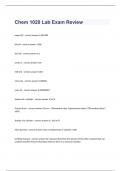
-
Chem 1020 Lab Exam Review questions and 100% correct answers
- Exam (elaborations) • 7 pages • 2023
-
- CA$20.30
- + learn more
mega (M) - correct answer 1,000,000 kilo (k) - correct answer 1,000 deci (d) - correct answer 0.1 centi (c) - correct answer 0.01 milli (m) - correct answer 0.001 micro (μ) - correct answer 0.000001 nano (n) - correct answer 0. Volume of a cylinder - correct answer V=πr²h Percent Error - correct answer % Error = (Theoretical value -Experimental value) /(Theoretical value) * 100% density of a cylinder - correct answer d = (m)/πr²h Mass percent - correct answer m...
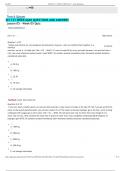
-
SCI 131 WEEK QUIZ QUESTIONS AND ANSWERS
- Exam (elaborations) • 13 pages • 2024
-
- CA$18.11
- + learn more
Tests & Quizzes SCI 131 WEEK QUIZ QUESTIONS AND ANSWERS Lesson 05 - Week 05 Quiz Return to Assessment List Part 1 of 1 - 100.0 Points Question 1 of 25 `Sodium and chlorine are very dangerous by themselves. However, when we combine them together in a chemical 4.0 Points reaction, we eat it--it's table salt: 2Na + Cl2 → 2NaCl. If I want to make 50.0 g of my own salt (because I can and that's how I roll), how much elemental sodium would I need? NOTE: All numbers locate...
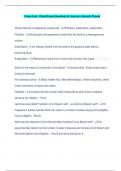
-
Chem Lab - Final Exam Questions & Answers Already Passed
- Exam (elaborations) • 7 pages • 2023
-
- CA$13.05
- + learn more
Chem Lab - Final Exam Questions & Answers Already Passed Three methods of separating compounds - ️️Filtration, sublimation, evaporation Filtration - ️️the process that separates a solid from the liquid in a heterogeneous mixture Sublimation - ️️A change directly from the solid to the gaseous state without becoming liquid Evaporation - ️️Removing a liquid from a mixture by turning it into a gas. Solve for the mass of a chemical in a container - ️️[mass total] - [mass empty d...
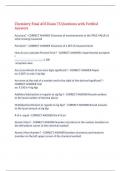
-
Chemistry Final ACS Exam 75 Questions with Verified Answers,100% CORRECT
- Exam (elaborations) • 7 pages • 2024
-
- CA$16.53
- + learn more
Chemistry Final ACS Exam 75 Questions with Verified Answers Accuracy? - CORRECT ANSWER Closeness of measurements to the TRUE VALUE of what is being measured Precision? - CORRECT ANSWER Closeness of a SET of measurements How do you calculate Percent Error? - CORRECT ANSWER I experimental-accepted I ____________________ x 100 accepted value Are zeros infront of non-zero digis significant? - CORRECT ANSWER Nope! ex: 0.0071 is only 2 sig figs Are zeros at the end of a number and...

Do you wonder why so many students wear nice clothes, have money to spare and enjoy tons of free time? Well, they sell on Stuvia! Imagine your study notes being downloaded a dozen times for $15 each. Every. Single. Day. Discover all about earning on Stuvia


